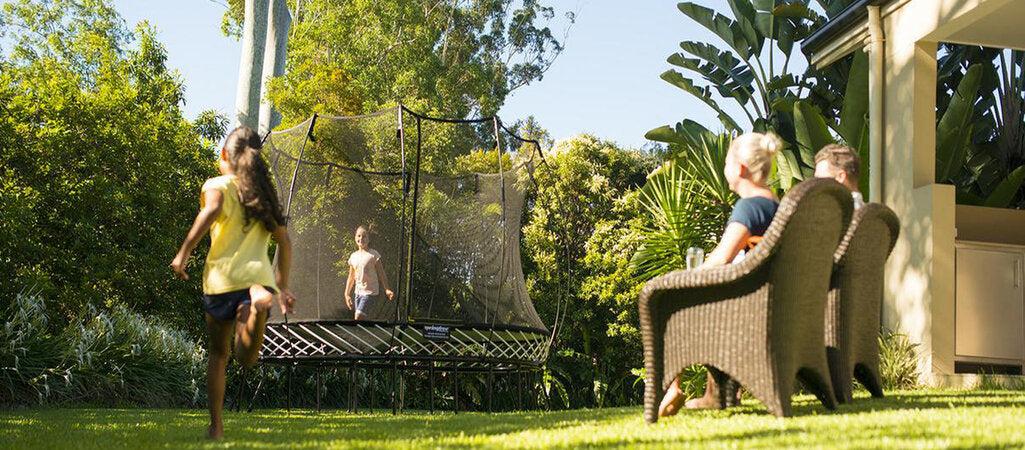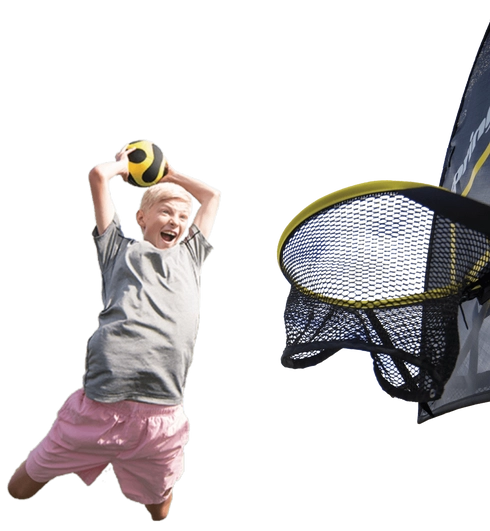What to Look for When Buying a Trampoline (7 Things)
Using our 20+ years of trampoline experience, we will go over what to look for when buying a trampoline, including pricing, size, safety & more!
min read

There is a lot to look for when buying a trampoline - more than you would think!
This is why you need to have a plan before deciding which trampoline is right for your family.
Buying the wrong trampoline that doesn’t fit your yard can result in frustration, wasted money, or worse, injury to your child.
At Springfree Trampoline, we will use our over 20 years of expertise as a trampoline manufacturer to go over seven important considerations before buying a trampoline.
Ready? Let's dive in to to your trampoline buying guide!
7 Things to Look for When Buying a Trampoline
Below is a proven template on how to choose a trampoline. Ask yourself these seven questions, and you'll be on the right track to choosing the right bounce for your backyard.
-
What Size Trampoline Do You Need?
The first question you need to ask yourself before anything else when buying a trampoline is: “Will this trampoline actually fit in my yard?”
Trampolines range in size from as small as six feet round and as large as 13 x 19 feet in diameter.
To determine if you can fit the trampoline into your yard, choose the trampoline model you like and measure your yard to find out how much space you have.
Let’s say you're interested in purchasing the Springfree Medium Oval Trampoline (see below).

Here are some of the key specifications you want to be aware of:
Jumping Mat Dimension- 8 ft, 11 ft
Trampoline Width (From one net rod to the other)- 10 ft, 5 in, 13 ft, 4 in
Trampoline Height- 9 ft
Trampoline Footprint- 7ft, 2in x 11ft, 10 in
Jumping Surface Area- 77 sq. Ft
IMPORTANT: While this may not be popular, our recommendation is to make room for additional safe clearance space, usually around 3-5 ft.
When measuring, make sure to account for the additional space. See the graphic below for a visual representation of clearance space:

Next, look for a section of your backyard that is clear of branches, debris, fences and slopes. Here are our recommendations to find the best space:
-
Flat and even (if the space you have isn’t level, we recommend the rise/gradient be no more than three degrees across the whole space. We don’t advise installing where the slope is greater than that).
-
Safe lateral clearance space of 1.5m on all sides of the trampoline.
-
Clean and free of obstacles or debris.
You can typically find the dimensions of the trampoline online; if not, contact the company whose trampoline you’re interested in and ask for dimensions.

-
Who Will Be Jumping on the Trampoline?
The trampoline model you choose also depends on who will be using the trampoline.
Is it just the kids? Will Mom and Dad also be jumping?
There’s a key number to look for that will qualify and disqualify trampoline models for your family: The trampoline’s single jumper weight capacity, or trampoline weight limit.
The single jumper weight capacity is based on how heavy you are and how high you jump. It is about ensuring jumpers don’t ‘bottom out’ (touch the ground while jumping).
Each trampoline will have this marked and depending on who will be using it, you may need a larger trampoline.
For example, the Springfree Mini-Round Trampoline has a single jumper weight capacity of 175 pounds.
Let's say you’re a parent that weighs over 175 pounds and you want to use the trampoline for workouts (an underrated aspect of trampolines!).
This means you would need to look into a trampoline model that has a higher single jumper weight capacity, like the Springfree Large Square Trampoline, whose single jumper weight capacity is 220 pounds.

Note: If you weigh more than the single jumper weight capacity it doesn’t mean the trampoline will break and you can’t use it.
However, you do run the risk of bottoming out if you reach maximum height on the trampoline and weigh over the single jumper weight capacity.
No matter what trampoline you’re looking at, figuring out who is going to be using the trampoline and how much they weigh will help you narrow down your trampoline options.
Springfree’s Advice: If you’re buying a trampoline for your child and you want them to grow with it, consider purchasing a large trampoline first.
It will ensure that the trampoline will last for your kiddos' full childhood and provide you with a greater return on investment.
-
What Type of Trampoline Do You Want?
There are two types of backyard trampolines on the market –- traditional spring-based trampolines and new springless trampolines.
A traditional spring trampoline, courtesy of Skywalker Trampolines:

Springless designs completely remove springs from the equation – this is the basis for our product line (hence, the “Springfree” name).
Instead of springs, springless trampolines use flexible composite rods that sit underneath the jumping surface to prevent injuries caused by the product itself.
Both traditional and springless trampolines provide solid bouncing surfaces, and most of the time, traditional trampolines will cost less than springless trampolines (more on pricing later).
Springless trampolines, however, have proven the be the safest trampoline design on the market by independent research.
When choosing the type of trampoline you want, ask yourself these questions to help guide you to your solution:
-
Would I rather have the less expensive trampoline with fewer, short-lived safety features? (Go with spring-based if you answered “Yes”)
-
Would I rather have the more expensive trampoline with higher-quality safety features? (Go with springless if you answered “Yes”)
-
How Safe Is the Trampoline?
You ask any parent, and most will say safety is at the top of the priority list when buying a trampoline and today’s trampolines have come a long way since you were a kid.
Today's trampoline safety standards state that trampolines should have an enclosure net but companies don't have to strictly follow the standards.
To get the ideal, and safest trampoline for your family, you must look at the specific safety features of the trampoline you’re interested in.
So, if you were looking at a Springfree Trampoline, you would want to take note of these features:
-
Mat Rods - Springfree Trampoline uses patented flexible composite rods that lie beneath the jumping surface out of harm’s way.
-
Hidden Frame - Springfree Trampoline’s frame is well beneath the jumping surface - you can’t hit it.
-
SoftEdge Mat - Springfree has created a shock-absorbent SoftEdge™ mat that eliminates any hard edges at the jumping surface.
-
FlexiNet Enclosure - Springfree Trampoline's proprietary FlexiNet enclosure has flexible net rods that cushion jumpers and prevent falls.

When researching a trampoline model, spend quality time assessing the safety features.
As a parent, there’s nothing more important than your child’s safety.
-
What Else Could You Use the Trampoline for?
Beyond just jumping and burning off energy, trampolines can be used for various activities—for both parents and kids.
We’ve already mentioned that trampolines can be a great source for workouts.
Some of the proven health benefits of trampolines include:
-
Improved heart and cardiovascular health
-
Good for your joint health
-
Develops your balance and coordination
-
Helps with weight loss
-
Improves mental health

In addition to working out, you can expand the trampoline’s use to other activities like basketball, camping or stargazing by including additional accessories.
For example, a lot of trampoline brands, like Springfree, Skywalker and Vuly, will offer a basketball set as an optional upgrade if your child wants to shoot some hoops while jumping on the trampoline.
If you and your family want to use the trampoline for other activities, vet out the different brands and find out which accessories you can include.
-
Can You Keep the Trampoline Up All Year?
The weather in your area can help determine the type of trampoline you buy.
In some cases, you can leave your trampoline outside all year long.
However, low-cost trampolines are more susceptible to damage from inclement weather.
If you’re concerned about the weather, look for these features in a trampoline:
- Galvanization of steel components.
- Maximum weight capacity of 1,300 lbs or more.
- Extensive warranty coverage - 10 years or more for key components like the frame and enclosure.
The weather could also play a factor in the types of accessories you buy for your trampoline.
For example, if you’re in a place that has 100-plus-degree summers, you likely would want to purchase some type of sunshade for your trampoline to provide UV protection for your family.
On the other hand, if you’re in a region that experiences cold temperatures and snow, it would be helpful to buy a cover to protect your trampoline against weather-related damage.

If weather is a concern for you, make sure to prioritize a model that is equipped with weather-resistant features, like rust-proof coating on the frame, and has accessories to help mitigate the impact of bad weather.
-
What Is the Price of the Trampoline?
We saved the big consideration for last, and that was intentional.
While price is typically the number one consideration for many people, the six factors discussed before cost are the most important to consider.
Why?
Those will get you to a trampoline that will fit and bring you the joy, safety and versatility you desire in a trampoline.
After considering the first six factors, you should be set up to find the best trampoline price possible for the RIGHT trampoline.
In some cases, this could mean going to a retailer like Walmart and buying a $200 trampoline.
In other cases, this might be purchasing a $4,000 trampoline with a bunch of accessories included.
Use the six previous factors discussed first to set your goals, and based on those goals, figure out your budget and how much you want to spend on a trampoline for your family.
Which Trampoline Is Right for You?
Once all the above points are considered, you're ready to choose your trampoline.
A lot of the next determining factors come down to personal preferences.
Do you like the look of the square model trampolines? The oval ones? What color trampoline would you want?
Once you figure that out, then you have set yourself up to find the best trampoline for your family.
If you're struggling to find the right size or shape, use our Model Comparison Tool to compare two Springfree Trampolines side-by-side.


